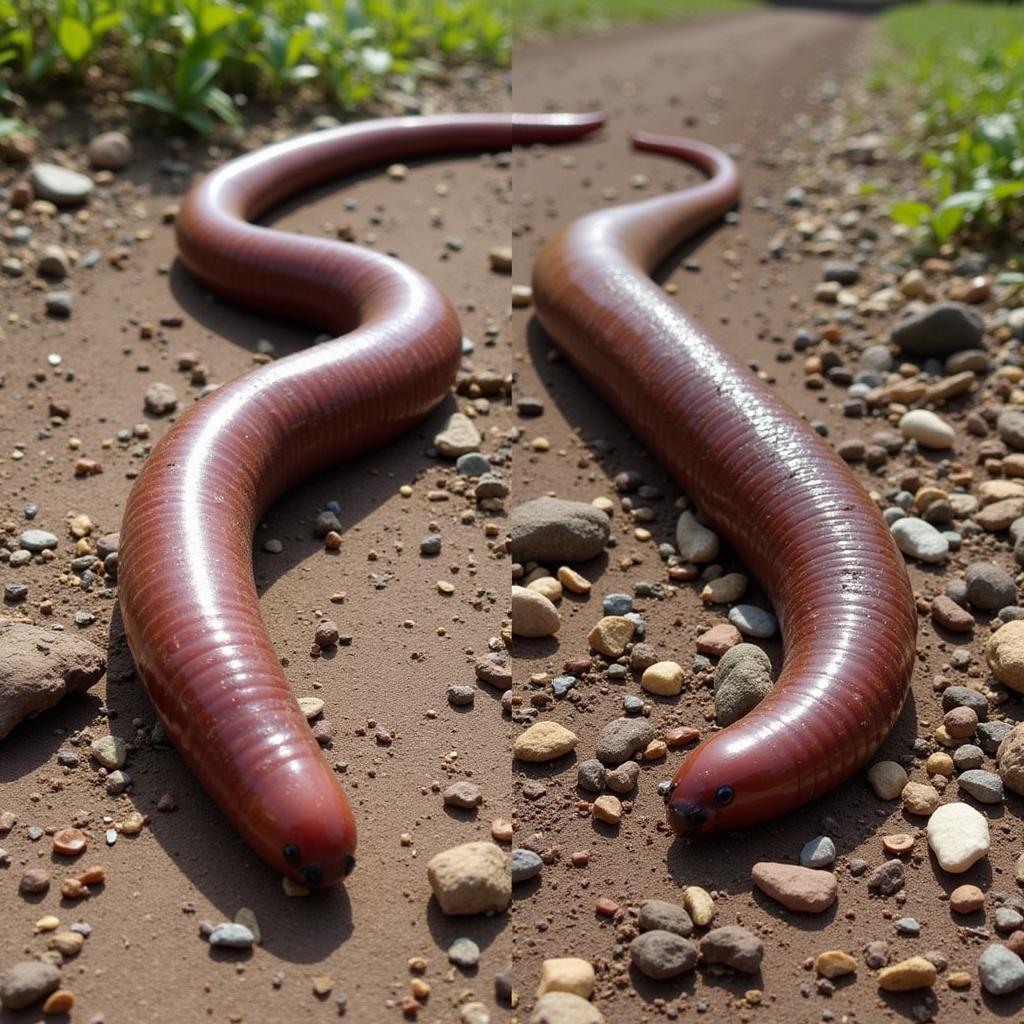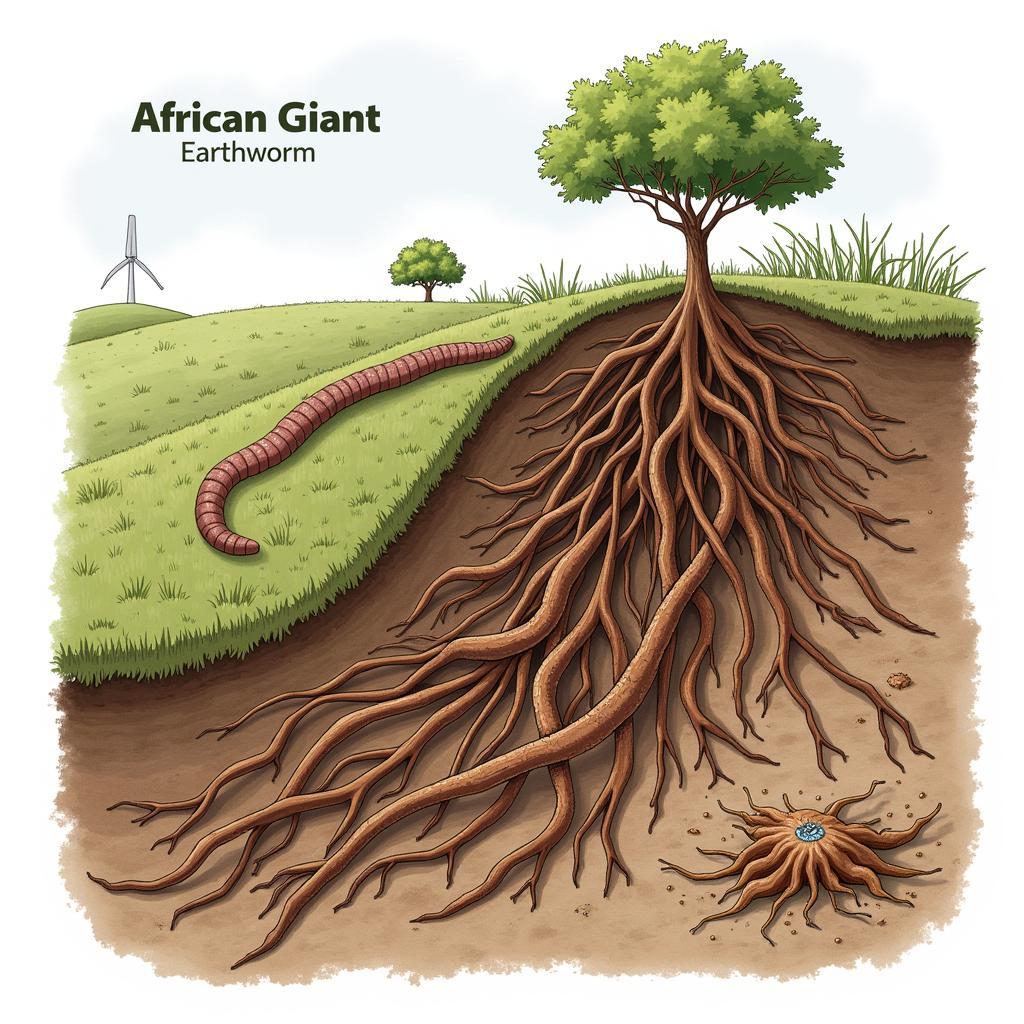Unraveling the Mystery of the African Giant Earthworm
The African Giant Earthworm, a creature often shrouded in myth and misconception, plays a vital role in the delicate ecosystems of sub-Saharan Africa. These fascinating invertebrates, much larger than their common counterparts, are more than just creepy crawlers; they are essential contributors to soil health and biodiversity.
Giants of the Underground: Size and Appearance
Contrary to popular belief, the African Giant Earthworm is not a single species but rather a group of several species belonging to the genus Microchaetus. These giants can reach impressive lengths, with some species growing up to 4-6 feet long. Imagine encountering one of these behemoths burrowing through the earth!
 African Giant Earthworm Size Comparison
African Giant Earthworm Size Comparison
Their size is not their only distinguishing feature. Unlike common earthworms with their reddish-brown hue, African Giant Earthworms exhibit a range of colors depending on the species. Some species boast a striking purplish-grey coloration, while others sport a bluish-grey tone.
Habitat and Distribution: Where the Giants Roam
These subterranean giants are native to the sub-Saharan regions of Africa, with a presence in countries like South Africa, Mozambique, and Kenya. Their distribution is largely influenced by soil type, moisture levels, and vegetation cover.
African Giant Earthworms thrive in areas with loose, well-drained soils rich in organic matter. They are particularly fond of forests, woodlands, and grasslands with sufficient rainfall to maintain the moist soil conditions they require.
A Gardener’s Best Friend: Ecological Importance
While their size might seem intimidating, these gentle giants are incredibly beneficial to the environment. Their burrowing activities are crucial for soil aeration, improving drainage and allowing air and water to penetrate deep into the ground. This, in turn, benefits plant growth and enhances overall soil fertility.
 African Giant Earthworm Soil Aeration
African Giant Earthworm Soil Aeration
Moreover, as they tunnel through the earth, they consume decaying organic matter, breaking it down into nutrient-rich castings that further enrich the soil. Their feeding habits contribute significantly to nutrient cycling and decomposition, making them invaluable assets to the ecosystems they inhabit.
“The presence of African Giant Earthworms is a strong indicator of a healthy and thriving ecosystem,” says Dr. Abena Owusu, a soil ecologist specializing in sub-Saharan ecosystems. “Their role in nutrient cycling and soil aeration is unparalleled, making them essential for the well-being of countless plant and animal species.”
Conservation Concerns: Protecting the Giants
Despite their ecological importance, African Giant Earthworms face increasing threats, primarily from habitat loss due to deforestation, agriculture, and urbanization. The conversion of their natural habitats to farmland and urban areas leads to habitat fragmentation and degradation, pushing these gentle giants towards an uncertain future.
Furthermore, the use of pesticides and fertilizers in agriculture can have detrimental effects on earthworm populations. These chemicals can contaminate the soil, directly harming the worms or disrupting their delicate life cycles.
The Future of the Giants: A Shared Responsibility
Protecting these incredible creatures and the vital ecosystems they support requires a concerted effort. Promoting sustainable land management practices, reducing deforestation, and minimizing the use of harmful chemicals in agriculture are crucial steps towards ensuring the survival of these gentle giants.
Their presence is a testament to the intricate balance of nature, reminding us of the interconnectedness of all living things and the importance of preserving biodiversity for generations to come.
FAQs about African Giant Earthworms
1. Are African Giant Earthworms harmful to humans?
No, African Giant Earthworms are harmless to humans. They are not venomous and do not bite.
2. What do African Giant Earthworms eat?
They primarily feed on decaying organic matter, such as leaves, roots, and animal dung.
3. How long do African Giant Earthworms live?
The lifespan of an African Giant Earthworm varies depending on the species but generally ranges from 2 to 5 years.
4. What is the role of African Giant Earthworms in traditional medicine?
In some cultures, African Giant Earthworms are believed to have medicinal properties and are used to treat a variety of ailments. However, scientific evidence to support these claims is limited.
5. How can I contribute to the conservation of African Giant Earthworms?
You can support organizations working to protect their habitats, promote sustainable land management practices, and raise awareness about their ecological importance.
Need More Information?
Explore our website for more fascinating articles about the diverse flora and fauna of Africa:
- Discover the beauty of African baskets, intricately woven masterpieces reflecting the continent’s rich artistic heritage.
- Delve into the world of the African driver ant queen, a fascinating creature known for its remarkable reproductive capabilities.
For any inquiries or assistance, please reach out to us at:
Phone: +255768904061
Email: [email protected]
Address: Mbarali DC Mawindi, Kangaga, Tanzania
Our dedicated customer support team is available 24/7 to assist you.
